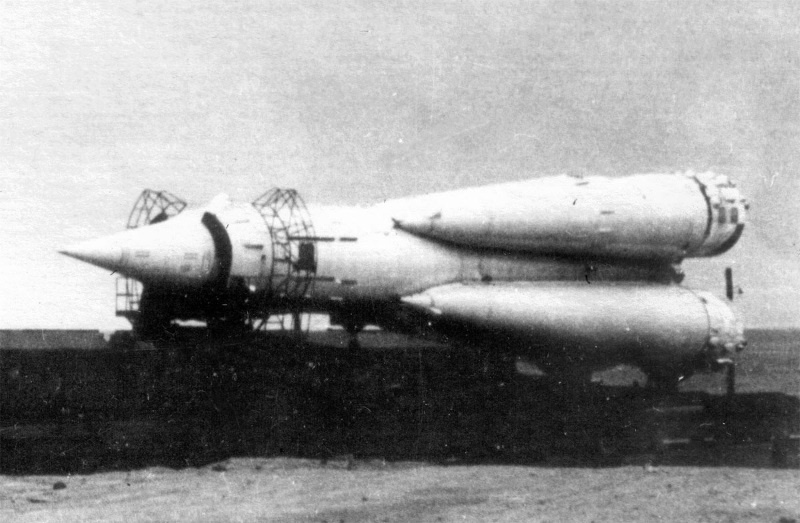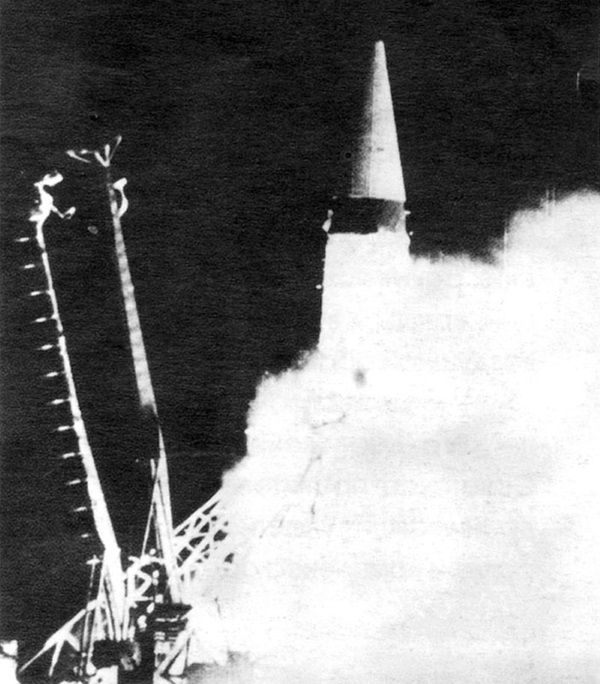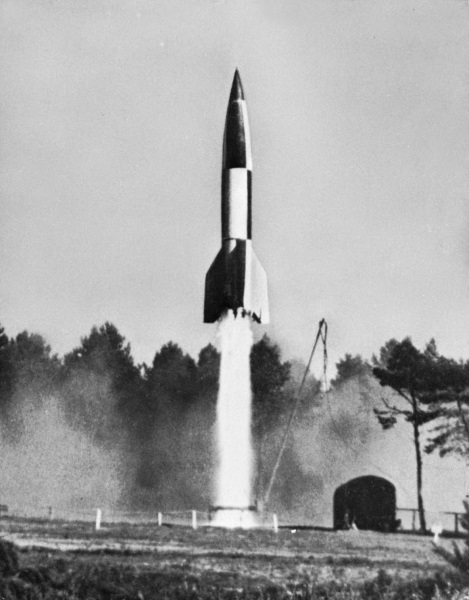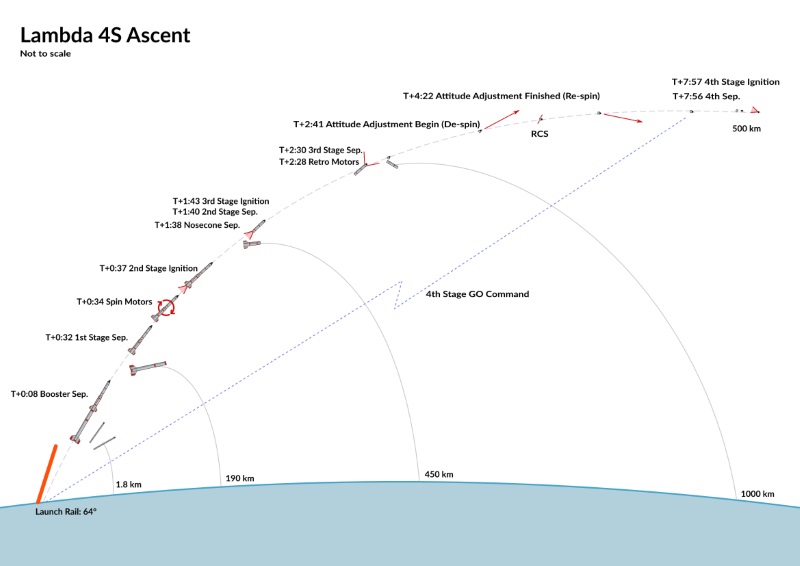First satellite: an alternative story
The launch of the first satellite was a big surprise, but on the whole the event was expected - the International Geophysical Year was on, and the intention was to launch the satellites as part of it in 1955 in the United States and the USSR. It is quite known that the United States almost put the object into orbit a year and a month earlier. And if you think about it, you can imagine scenarios in which the satellite would have been launched even earlier. Let's try to imagine how this could be.

Removal of the R-7 rocket at the launch, photos of Roscosmos

Satellite Vanguard TV3 in the museum, photo RadioFan / Wikipedia
The first satellite weighed 83 kg, which is quite a lot, and it may not be easy to launch the same mass with rockets of alternative history. Of the real first satellites, the lightest was Vanguard TV3, whose launch attempt on December 6, 1957 ended in failure . He weighed only 1.36 kg. Therefore, it is possible to take 1 kg as the estimated minimum payload. For each scenario, we will also try to figure out how this could be realized.

Launch of the R-7 rocket, photo by RSC Energia
It is known that the P-7 did not start flying right away. During the first launch on May 15, 1957, a fire started on the side block, the block lost traction a few seconds before the separation, fell off and led to the destruction of the package. Several attempts to start the engines on June 11 failed, and the rocket did not even come off the launch pad. On July 12, an error in the new device led to the fact that a hindrance began to act on the control system, the rocket spun around the longitudinal axis and collapsed. Successful launches on August 21 and September 7 showed that the thermal protection of the warhead is insufficient, and it is impossible to continue testing under the military program of an intercontinental ballistic missile. A quickly made simplest satellite was put on the released rocket, which became the first in the history of mankind.
Is it possible to speed up the launch of the first satellite? It is easy - if they didn’t put the faulty device on July 12, if there were no bad luck with a frozen valve and a problem in the engine on June 11, and if, before the first launch, the designers remembered about the need to check tight connections after transporting the rocket by rail Under the circumstances, the first two launches on May 15 and June 11 are successful, show the inadequate thermal protection of the warhead, and the first satellite is sent on a flight already in the area on July 12.

Rocket Juno I in the shop, clearly visible upper steps, source: Drew Ex Machina
Back in 1954, at a meeting of the American Rocket Society, Werner von Braun proposed launching a satellite, and he already had a real opportunity for that. Since 1953, the Redstone rocket created by him began to fly, several stages of solid-fuel engines could be put on it, and the total gained speed should have been enough to put a small payload into orbit. But the project Orbiter von Braun lost the competition to the Vanguard project, which was originally American and was not burdened by the history of emigration from defeated Nazi Germany. Even after the launch of the Soviet satellite, Vanguard retained its priority, and it needed an epic explosion before the press, so that von Braun would finally give the green light. With three additional solid-fuel stages (one of them is rigidly connected with the satellite) and under the name Juno I, the Redstone rocket deduced on February 1, 1958 the first American satellite.
Almost in the same version, but with fourth-stage models and a satellite called Jupiter-C, the Redstone rocket launched on September 20, 1956. The flight was successful, it reached a speed of 7 km / s, an altitude of 1100 km and a range of 5300 km. If instead of sand on a rocket there was a working fourth step, then it could well turn out to go into orbit. But in our reality, according to the stories, the government discharged the whole of General John Medaris to check whether von Braun had secretly put the fourth step. In the future, Jupiter-C was used to test the thermal protection of the warheads of the developed Jupiter missile.
Technically, it was possible to assemble a Redstone rocket with solid propellant steps and launch a satellite since 1953, but everything was limited by the lack of interest on the political Olympus. If we assume that von Braun (or another space enthusiast) could convince a sufficient number of decision makers that the launch of the first satellite would be a historical event with a huge PR effect, the first satellite could have been launched even then. The scenario, when the satellite and the fourth stage are loaded in secret and launched in September 1956, looks like a movie and is not realistic. It is unlikely that von Braun would have risked his entire career for the sake of priority. Theoretically, his actions could justify in hindsight, they say, "the winners are not judged," but these are very dubious constructions. Also here a curious problem appears - Juno I could not put satellites weighing more than a dozen kilograms into orbit. And more load-lifting rockets would have to wait for years. A loud launch of the space age could turn into a long period of stagnation, when restrictions on the mass of satellites would not allow launching anything as complex as it could be.
At this realistic scenarios end, and then go fantasy.

Start "V-2"
Could it be possible to launch a satellite on any modification of the V-2? In the original version - no. Engine "V-2" was 26 tons against 36 at Redstone, and the specific impulse - 203 seconds at sea level against 235 at Redstone. Plus, a normal solid fuel mix will not appear before 1947, so that the upper solid fuel stages would also be less effective. The lack of material evidence means that the two-stage intercontinental A-9 / A-10 rocket, which they wanted to use for the US shelling, did not go further than the sketches. But, theoretically, if in the late 1930s, instead of military developments, von Braun was given the task of launching a satellite and provided with resources, he could well have done it in the 1940s. But for then, many extremely serious changes in history would be required.

Rocket Lambda-4S, photo Momotarou2012 / Wikipedia
Probably, the deadline when it would be possible to launch a satellite without high technologies that had fallen from the sky are the thirties. But for this, it would have to involve the knowledge and experience of the second half of the 20th century, and, what is most amusing, the Soviet Union becomes a country that could do this. Until 1942 (the first launch of the V-2), there are no powerful liquid rocket engines in the world. Therefore, the only option is solid fuel. Before the invention of composite fuels, the only option is ballistic powder. This is a specially processed smokeless powder that burns more slowly. He has a low specific impulse, in the region of 200 seconds, but this is still more than two times better than the specific impulse of black powder. The USSR develops Katyusha in the late 30s, therefore it is the world leader in the development and production of ballistic powder for missiles. In the 30s, it is impossible to make a full-fledged control system (a rocket in flight maintains an unstable equilibrium, like a pencil on a finger), and here it is necessary to take advantage of the Japanese experience. Launch Lambda-4S, first launched in 1966, used a minimum of complex electronics. She started with a ramp, induced on the desired angle. Then the rocket spun up and maintained stability on the principle of a top. Before the separation of the last, fifth, stage, the control system turned it along the axis of rotation of a single gyroscope. Such a primitive control system could be created in the 30s.

Lambda-4S derivation scheme, source: open-aerospace.github.io
Due to the smaller specific impulse, there would be many steps, no less than three, and the payload would be minimal. Instead of a radio transmitter, you probably would have to deploy, for example, a reflector — a transmitter and batteries would be too heavy. But technically the scheme turns out quite workable.
In addition to amusing technical tasks, such experiments with an alternative history suggest a curious thought - the launch of the first satellite took place at a very good time and was made the most suitable country for this. If the United States were the first to launch a satellite, then such an intense space race might not have happened. In the end, overcoming the sound barrier in the United States in 1947, even if it caused some excitement, did not turn the world upside down. A good time is called because the Soviet Union was already prepared very powerful booster, and the United States was finishing the development of their own. A variety of technologies were ready to connect and cause the extremely rapid development of astronautics.
Happy holiday! On the 60th anniversary of the launch of the first satellite!

Removal of the R-7 rocket at the launch, photos of Roscosmos
Formulation of the problem

Satellite Vanguard TV3 in the museum, photo RadioFan / Wikipedia
The first satellite weighed 83 kg, which is quite a lot, and it may not be easy to launch the same mass with rockets of alternative history. Of the real first satellites, the lightest was Vanguard TV3, whose launch attempt on December 6, 1957 ended in failure . He weighed only 1.36 kg. Therefore, it is possible to take 1 kg as the estimated minimum payload. For each scenario, we will also try to figure out how this could be realized.
Scenario 1. Luck and forethought

Launch of the R-7 rocket, photo by RSC Energia
It is known that the P-7 did not start flying right away. During the first launch on May 15, 1957, a fire started on the side block, the block lost traction a few seconds before the separation, fell off and led to the destruction of the package. Several attempts to start the engines on June 11 failed, and the rocket did not even come off the launch pad. On July 12, an error in the new device led to the fact that a hindrance began to act on the control system, the rocket spun around the longitudinal axis and collapsed. Successful launches on August 21 and September 7 showed that the thermal protection of the warhead is insufficient, and it is impossible to continue testing under the military program of an intercontinental ballistic missile. A quickly made simplest satellite was put on the released rocket, which became the first in the history of mankind.
Is it possible to speed up the launch of the first satellite? It is easy - if they didn’t put the faulty device on July 12, if there were no bad luck with a frozen valve and a problem in the engine on June 11, and if, before the first launch, the designers remembered about the need to check tight connections after transporting the rocket by rail Under the circumstances, the first two launches on May 15 and June 11 are successful, show the inadequate thermal protection of the warhead, and the first satellite is sent on a flight already in the area on July 12.
Scenario 2. Politics and disobedience

Rocket Juno I in the shop, clearly visible upper steps, source: Drew Ex Machina
Back in 1954, at a meeting of the American Rocket Society, Werner von Braun proposed launching a satellite, and he already had a real opportunity for that. Since 1953, the Redstone rocket created by him began to fly, several stages of solid-fuel engines could be put on it, and the total gained speed should have been enough to put a small payload into orbit. But the project Orbiter von Braun lost the competition to the Vanguard project, which was originally American and was not burdened by the history of emigration from defeated Nazi Germany. Even after the launch of the Soviet satellite, Vanguard retained its priority, and it needed an epic explosion before the press, so that von Braun would finally give the green light. With three additional solid-fuel stages (one of them is rigidly connected with the satellite) and under the name Juno I, the Redstone rocket deduced on February 1, 1958 the first American satellite.
Almost in the same version, but with fourth-stage models and a satellite called Jupiter-C, the Redstone rocket launched on September 20, 1956. The flight was successful, it reached a speed of 7 km / s, an altitude of 1100 km and a range of 5300 km. If instead of sand on a rocket there was a working fourth step, then it could well turn out to go into orbit. But in our reality, according to the stories, the government discharged the whole of General John Medaris to check whether von Braun had secretly put the fourth step. In the future, Jupiter-C was used to test the thermal protection of the warheads of the developed Jupiter missile.
Technically, it was possible to assemble a Redstone rocket with solid propellant steps and launch a satellite since 1953, but everything was limited by the lack of interest on the political Olympus. If we assume that von Braun (or another space enthusiast) could convince a sufficient number of decision makers that the launch of the first satellite would be a historical event with a huge PR effect, the first satellite could have been launched even then. The scenario, when the satellite and the fourth stage are loaded in secret and launched in September 1956, looks like a movie and is not realistic. It is unlikely that von Braun would have risked his entire career for the sake of priority. Theoretically, his actions could justify in hindsight, they say, "the winners are not judged," but these are very dubious constructions. Also here a curious problem appears - Juno I could not put satellites weighing more than a dozen kilograms into orbit. And more load-lifting rockets would have to wait for years. A loud launch of the space age could turn into a long period of stagnation, when restrictions on the mass of satellites would not allow launching anything as complex as it could be.
At this realistic scenarios end, and then go fantasy.
Scenario 3. With and without war

Start "V-2"
Could it be possible to launch a satellite on any modification of the V-2? In the original version - no. Engine "V-2" was 26 tons against 36 at Redstone, and the specific impulse - 203 seconds at sea level against 235 at Redstone. Plus, a normal solid fuel mix will not appear before 1947, so that the upper solid fuel stages would also be less effective. The lack of material evidence means that the two-stage intercontinental A-9 / A-10 rocket, which they wanted to use for the US shelling, did not go further than the sketches. But, theoretically, if in the late 1930s, instead of military developments, von Braun was given the task of launching a satellite and provided with resources, he could well have done it in the 1940s. But for then, many extremely serious changes in history would be required.
Option 4. Magic hitcher

Rocket Lambda-4S, photo Momotarou2012 / Wikipedia
Probably, the deadline when it would be possible to launch a satellite without high technologies that had fallen from the sky are the thirties. But for this, it would have to involve the knowledge and experience of the second half of the 20th century, and, what is most amusing, the Soviet Union becomes a country that could do this. Until 1942 (the first launch of the V-2), there are no powerful liquid rocket engines in the world. Therefore, the only option is solid fuel. Before the invention of composite fuels, the only option is ballistic powder. This is a specially processed smokeless powder that burns more slowly. He has a low specific impulse, in the region of 200 seconds, but this is still more than two times better than the specific impulse of black powder. The USSR develops Katyusha in the late 30s, therefore it is the world leader in the development and production of ballistic powder for missiles. In the 30s, it is impossible to make a full-fledged control system (a rocket in flight maintains an unstable equilibrium, like a pencil on a finger), and here it is necessary to take advantage of the Japanese experience. Launch Lambda-4S, first launched in 1966, used a minimum of complex electronics. She started with a ramp, induced on the desired angle. Then the rocket spun up and maintained stability on the principle of a top. Before the separation of the last, fifth, stage, the control system turned it along the axis of rotation of a single gyroscope. Such a primitive control system could be created in the 30s.

Lambda-4S derivation scheme, source: open-aerospace.github.io
Due to the smaller specific impulse, there would be many steps, no less than three, and the payload would be minimal. Instead of a radio transmitter, you probably would have to deploy, for example, a reflector — a transmitter and batteries would be too heavy. But technically the scheme turns out quite workable.
Conclusion
In addition to amusing technical tasks, such experiments with an alternative history suggest a curious thought - the launch of the first satellite took place at a very good time and was made the most suitable country for this. If the United States were the first to launch a satellite, then such an intense space race might not have happened. In the end, overcoming the sound barrier in the United States in 1947, even if it caused some excitement, did not turn the world upside down. A good time is called because the Soviet Union was already prepared very powerful booster, and the United States was finishing the development of their own. A variety of technologies were ready to connect and cause the extremely rapid development of astronautics.
Happy holiday! On the 60th anniversary of the launch of the first satellite!
All Articles